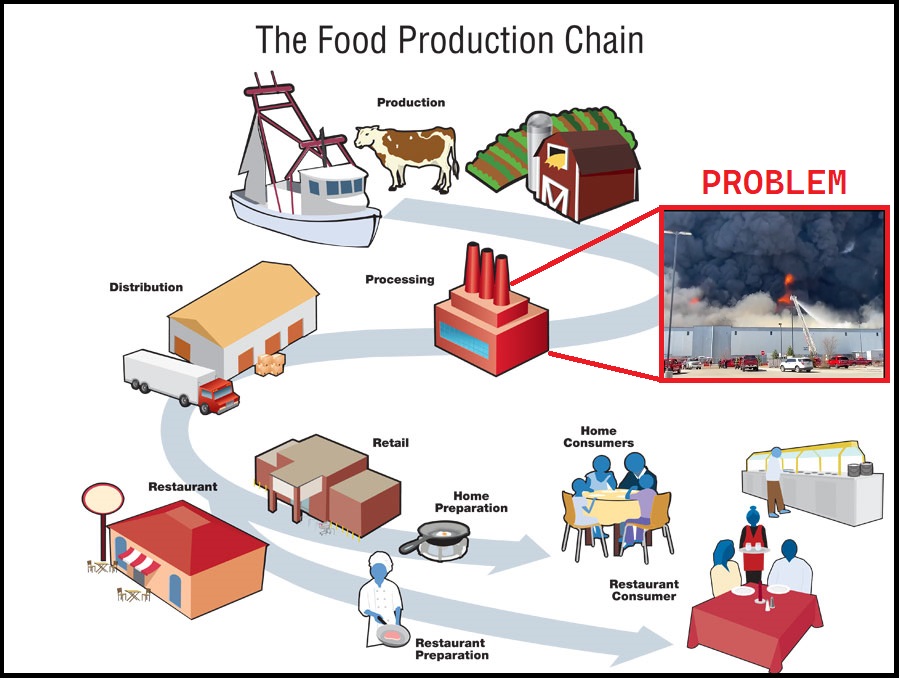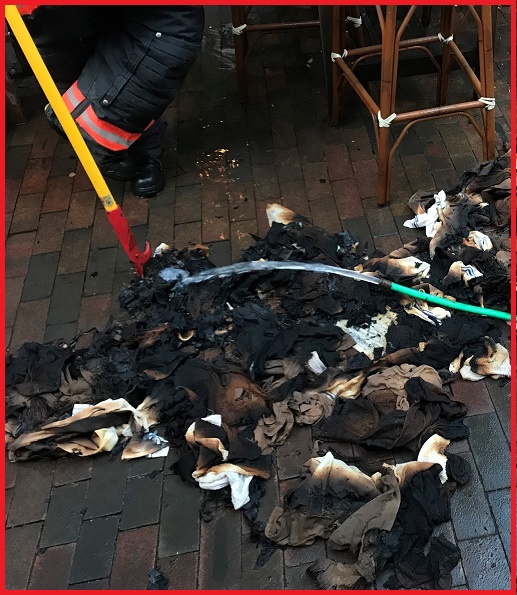Increase in Industrial Accidents at Food Processing Plants Has Raised Suspicions
Several people have written to inquire about recent stories surrounding a wave of industrial accidents at food processing plants all over the U.S. {Zero Hedge Article} {Twitter Questions, Suspicions} {List from Western Standard}
Indeed, there has been a significant increase in fires and explosions from furnaces, industrial fryers, boilers and some other rather odd incidents with aircraft hitting food processing. The frequency even gathered attention from Fox News host Tucker Carlson. WATCH:
Addressing the lesser frequent impact incidents from airplanes etc. Keep in mind that major industrial food processing facilities are generally located around major transportation hubs – large arteries for commercial trucking and railway lines for inbound good deliveries. These are the same zoned commercial regions where you find small regional airports.
So, let’s put those airplane ‘accidents” aside for a moment and look at the bigger picture.

Yes, there has been an increase in industrial accidents at some major and regional food processing plants. However, this may be the cumulative effect of what CTH was warning about since early 2020 when the food processing supply chain was completely screwed up by govt intervention.
When the restaurant, hotel, cafeteria, school lunchroom, food trucks and hospitality venues were shut down by government COVID mitigation, they represented about 60% of all food consumption. That pushed everyone into the retail side, grocery stores and supermarkets for food purchases.
When 60% of the demand shifted into the system that represents the other 40% of total food delivery, the processing side of the total food supply chain went into maximum stress and overdrive. CTH warned about the limits and capacities of this sector and the potential future problems that would surface.
Commercial food operations, industrial kitchens and massive food processing organizations were forced to increase food production on a scale that is almost unimaginable. Empty store shelves were the immediate result of massive increases in demand. The entire supply chain was pushed beyond capacity and remained beyond operational capacity for well over 18 months.
Two shift processing operations added a third and fourth shift for workers. Unlimited overtime with everyone working round the clock was the outcome. The food processing and distribution supply chain went into 24/7 emergency operations to try and compensate for the extreme demand.
What we are seeing now is likely, in large part, a downstream consequence from industrial kitchens putting preventative maintenance on the side in order to keep the processing going.
Boilers never turned off, furnaces running 24/7, exhaust fans and industrial turbines running all day and night along with all the attached equipment. I suspect much of the equipment that keeps the industrial processing and kitchens operating were not given the appropriate amount of down-time and deep maintenance that would normally take place.
Think of it like your clothes dryer at home. Instead of running two loads of laundry a day, now you are operating that dryer 24/7 to keep up with the mounting piles of soiled linens. You generate several years’ worth of lint buildup in your exhaust vent each month you continue. If you pause to clean out the vent, the linens pile up. A similar scenario happens in industrial kitchens and food processing.
 Suddenly, the 30-gal tub of oiled/soiled rags fills up faster, and the contract for pickup doesn’t compensate or arrive with a faster rotation schedule.
Suddenly, the 30-gal tub of oiled/soiled rags fills up faster, and the contract for pickup doesn’t compensate or arrive with a faster rotation schedule.
An old cloth filled with food grade mineral residue triggers a chemical reaction….
Industrial fryers that must be purged every 6-hr cycle of operation don’t get purged because the retention system for the old grease is full and not getting pumped as fast to keep up with the increased production cycles.
Stuff like this starts to happen when you run an industrial system beyond capacity. Perhaps the grease is loaded into buckets or drums as an offset, but that needs to be stored somewhere…. where they are not used to storing it… etc.
Industrial vents don’t get cleaned more frequently to keep up with the new 24/7 operation. Regular maintenance schedules are deferred for massive furnaces that need time to cool, clean and restart.
The same applies to boilers and HVAC systems that were not designed for the capacity now required. In short, there’s a whole lot of maintenance that gets put down the priority list when everyone in the organization is shouting to keep everything running.
I’m not trying to justify the issue, excuse or blame the facility. I’m just explaining how all kinds of industrial accidents can spike when the operational systems within a specific industry are running maximum throttle, month after month after month.
Then there’s the exhausted people; literally the workers who are physically and mentally drained from the overcapacity issues. And don’t think the regulatory agencies (USDA, health inspectors, etc) wouldn’t also tell their compliance officers to give the industry a little slack. I guarantee they did.
The added hours, the added shifts, the days off that can’t take place. All of that leads to short cuts and things left undone that would normally be done under regular operations. People burn out just like equipment, and tired people take shortcuts.
I’ll look closely to see if there is an uptick in workers comp claims within the industrial food processing sector, but I suspect there is. Heck, why wouldn’t there be? It would be natural to see more worker injuries along with industrial accidents under these conditions.
Does that explain all of the incidents? Maybe not, but the fact that U.S. food processing has been running beyond capacity, might put a better context on why that same specific segment of U.S. industrial output would be seeing more industrial accidents.
Another downstream consequence could be an uptick in food recalls as an outcome of increased bacteria within the food processing equipment, because the break-down-time, sanitation and hygiene might be impacted by excessive operational run times. There’s a myriad of issues from any industrial operation that goes from ordinary capacity to seriously over-stressed maximum capacity… and then remains in the emergency phase for months.
Like I said two years ago, the downstream ramifications of those decisions were going to be a major problem.
March 15, 2020 – […] “A government cannot just shut down 30 to 50 percent of the way civil society feeds themselves, without planning and advanced preparation for an alternative. Those who ARE the alternative, the processors and retail food grocers, need time to prepare themselves (and their entire logistical system) for the incredible impact. Without preparation this is a man-made crisis about to get a lot worse. (LINK)
FUBAR…
… or it could be something nefarious. Suspicious Cat always remains, well, suspicious.






Post a Comment